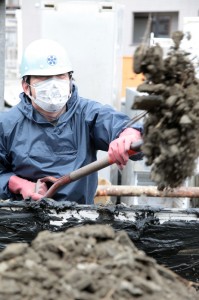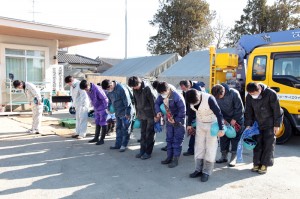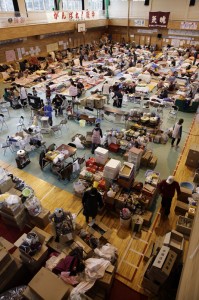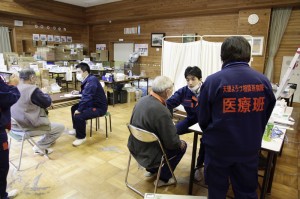Tenrikyo Disaster Relief Hinokishin Corps embarks on full-scale recovery efforts in Miyagi Prefecture
On April 2, the base of operations for Tenrikyo Disaster Relief Hinokishin Corps’s relief activities in Miyagi Prefecture was relocated from the Miyagi Diocese Office in Sendai City to the coastal city of Higashimatsushima, which was devastated by the March 11 earthquake and tsunami. The corps’s relocation was made at the request of Higashimatsushima City. From April 4 to 6, the corps from Shiga and Gifu dioceses joined forces to clear mud from the roads and remove the mountains of wreckage left by the brutal tsunami. Spurring them on in their relief activities was their deep concern for the well-being of the evacuees, many of whom are understandably exhausted from their prolonged stay in evacuation centers and worried about their future.
The corps set up its base of operations in a community center located three kilometers (about 2 mi.) inland from the coast. Unlike in districts closer to the coast, the houses and buildings in this area were not washed away by the tsunami. Nonetheless, the area was flooded by seawater and, for about 10 days following the tsunami, remained inundated by two meters (about 6.5 ft.) of water. The corps’s relocation to the center began on March 28 with the arrival of 15 members of Tokyo Diocese’s corps, who had been distributing water in Sendai City. Joined on the 30th by 25 members of Aichi Diocese’s corps, they worked to clean up and restore the community center and its grounds, which had also been flooded. The community center was ready to be opened as the corps’s base of operations on April 2.
 The task assigned to the corps by the city’s Disaster Response Task Force was to clear mud and debris from the roads in an area measuring two kilometers square (about 1.2 mi. sq.). On the morning of April 4, 15 members of Shiga Diocese’s corps and 16 members of Gifu Diocese’s corps set about their task. Shiga Diocese’s corps started clearing roads in a housing area 50 meters (about 55 yd.) from the community center. The mud covering the road was 20 centimeters (about 8 in.) deep. The members loaded the mud onto two trucks, which transported it to a dump located six kilometers (3.7 mi.) from the site. In the intervals while waiting for the trucks to return from the dump, the members responded to local residents requests for help in removing sludge from their homes.
The task assigned to the corps by the city’s Disaster Response Task Force was to clear mud and debris from the roads in an area measuring two kilometers square (about 1.2 mi. sq.). On the morning of April 4, 15 members of Shiga Diocese’s corps and 16 members of Gifu Diocese’s corps set about their task. Shiga Diocese’s corps started clearing roads in a housing area 50 meters (about 55 yd.) from the community center. The mud covering the road was 20 centimeters (about 8 in.) deep. The members loaded the mud onto two trucks, which transported it to a dump located six kilometers (3.7 mi.) from the site. In the intervals while waiting for the trucks to return from the dump, the members responded to local residents requests for help in removing sludge from their homes.
The members of Gifu Diocese’s corps simultaneously began working on a road that connects the area with the coastal area. Mud and huge piles of wreckage lined both sides of the road. While removing the wreckage, the members separated it according to classifications specified by the authorities, such as “tatami mats,” “electrical appliances,” and “mixed refuse.” The members then used heavy machinery to load the separated items onto a four-ton truck. Many residents also asked the corps members to help them remove sludge and damaged electrical appliances from their homes. One resident said: “I can’t thank them enough for removing the sludge. I was amazed at how these Tenrikyo followers seem to find their reason for living in helping others. I will remember their blue helmets as long as I live.” On this day alone, the corps of Shiga and Gifu dioceses used four two-ton trucks to remove 30 loads of mud and one four-ton truck to remove four loads of wreckage, including 100 tatami mats.
On April 5, Shiga Diocese’s corps removed mud from the precincts of Akai Community Gymnasium, which had been designated as an evacuation center, while Gifu Diocese’s corps continued to remove mud and wreckage from roads.
 An official from Higashimatsushima City’s Disaster Response Task Force said: “Miyagi Prefecture has been battered by a number of earthquakes and tsunami in recent years. On each of those occasions, Tenrikyo Disaster Relief Hinokishin Corps came to our rescue. Following the Sanriku-Minami Earthquake of 2003, for instance, the members of Miyagi Diocese’s corps as well as other dioceses’ corps won the admiration of our community members for their assistance in helping to dismantle destroyed homes and remove wreckage. Because of that relationship with Tenrikyo’s corps, we immediately requested their help once again in the wake of this disaster. Presently the corps members are responding to requests from our community members as well as swiftly embarking on recovery operations. Having them here to help us is extremely reassuring. Many of our community members have already contacted our office to tell us how happy and thankful they are for the corps’s assistance, and all of us, starting with Mayor Hideo Abe, would like to express our heartfelt gratitude, as well.”
An official from Higashimatsushima City’s Disaster Response Task Force said: “Miyagi Prefecture has been battered by a number of earthquakes and tsunami in recent years. On each of those occasions, Tenrikyo Disaster Relief Hinokishin Corps came to our rescue. Following the Sanriku-Minami Earthquake of 2003, for instance, the members of Miyagi Diocese’s corps as well as other dioceses’ corps won the admiration of our community members for their assistance in helping to dismantle destroyed homes and remove wreckage. Because of that relationship with Tenrikyo’s corps, we immediately requested their help once again in the wake of this disaster. Presently the corps members are responding to requests from our community members as well as swiftly embarking on recovery operations. Having them here to help us is extremely reassuring. Many of our community members have already contacted our office to tell us how happy and thankful they are for the corps’s assistance, and all of us, starting with Mayor Hideo Abe, would like to express our heartfelt gratitude, as well.”
The corps from Shiga and Gifu dioceses were reinforced by the corps from Aichi, Yamanashi, Hokkaido, and Kyoto dioceses. On April 10, the local elementary school that had been serving as the community’s evacuation center reopened for the new school year, thus making it necessary for the evacuees to move into the community center that had been serving as the corps’s base of operations. The corps members, therefore, moved to a Self Defense Force post, where they set up camp in an open lot. While basing themselves there, the members continued to remove mud and wreckage from the area. As of April 12, the total number of corps members who had taken part in those efforts in Miyagi Prefecture stood at 901.
Ikoi-no-Ie Hospital staff conducts medical relief activities at an evacuation center in Miyagi Prefecture
 Many evacuees who have been living in evacuation shelters since the disastrous March 11 earthquake and tsunami are experiencing physical and mental strain, which is causing symptoms such as insomnia and loss of appetite. To cope with the situation, medical relief teams from around the country have been sent to the devastated areas.
Many evacuees who have been living in evacuation shelters since the disastrous March 11 earthquake and tsunami are experiencing physical and mental strain, which is causing symptoms such as insomnia and loss of appetite. To cope with the situation, medical relief teams from around the country have been sent to the devastated areas.
On April 8, Nara Prefecture sent its sixth medical relief team—consisting of eight staff members from Tenri’s Ikoi-no-Ie Hospital—to Kesennuma City, Miyagi Prefecture. Basing themselves at Koharagi Junior High School, an officially designated evacuation center sheltering 188 people, the medical relief team spent five days examining and treating evacuees. The team consisted of three doctors, three nurses, a pharmacist, and a clinical laboratory technician.
Koharagi Junior High School is located in the city’s Osawa district, where the tsunami destroyed 150 of the district’s 180 houses. In addition, 40 of the residents lost their lives in the disaster, while nine are still missing. The evacuees from the community are presently living on the floor of the school’s gymnasium. A medical consultation room has been set up in the school cafeteria adjacent to the gymnasium.
 On the day of their arrival, the medical relief team immediately set about treating evacuees and making house calls to people in the neighborhood. Over the next four days, the team examined evacuees from 9:00 a.m. until 7:00 p.m. Their patients included not only people living at the evacuation center but also people living in the community who had taken the bus or driven their cars to reach the center. Out of the 35 medical facilities in the city, many were destroyed or damaged by the tsunami. Presently, only 17 are capable of examining patients, although five more are preparing to open soon.
On the day of their arrival, the medical relief team immediately set about treating evacuees and making house calls to people in the neighborhood. Over the next four days, the team examined evacuees from 9:00 a.m. until 7:00 p.m. Their patients included not only people living at the evacuation center but also people living in the community who had taken the bus or driven their cars to reach the center. Out of the 35 medical facilities in the city, many were destroyed or damaged by the tsunami. Presently, only 17 are capable of examining patients, although five more are preparing to open soon.
Most of the patients consulting the doctors were suffering from colds, although many others complained of insomnia. A 70-year-old fisherman who had lost both his home and fishing boat in the catastrophe said: “I spent so many years living together with the sea, but now I’m terrified just to look at it. I’m so nervous that I can’t sleep at night. . . .” The doctors and nurses on the team listened to the patients’ personal accounts of the tsunami and did their best to help relieve their stress.
The team also drove through devastated areas of the district making house calls at individual homes as well as facilities that had requested their assistance.  For example, they treated a woman in her nineties who was suffering from bedsores, an elderly person with a broken leg, and a disabled person suffering from high fever.
For example, they treated a woman in her nineties who was suffering from bedsores, an elderly person with a broken leg, and a disabled person suffering from high fever.
In addition to these activities, the members of the medical relief team also made rounds inside the gymnasium to keep tabs on the physical condition of the evacuees as well as offer them advice on how to cope with their stressful living conditions. During the five days, the team examined and treated a total of 145 patients, including 23 who were examined during house calls.
Disaster relief corps members play games with children in Higashimatsushima
Three members of the disaster relief corps from Shiga Diocese hit upon the idea of holding a “game fest” for children of evacuees living at Akai Community Gymnasium, an evacuation center housing about 200 people, which is located near the corps’s base of operations in Higashimatsushima City, Miyagi Prefecture. One of the three members, Kazuki Tani, who is a committee member of his church’s Boys and Girls Association, said: “We wanted to do something for the evacuees even after our daytime tasks had ended, so we hit upon the idea of trying to cheer up the children living at the center by playing simple games with them.”
Visiting the evacuation center, he explained the proposal to the supervisor, who readily agreed. After introducing themselves as members of Tenrikyo’s disaster relief corps and expressing their condolences to the evacuees, the three members set about playing games and singing songs with the children, who ranged in age from four to 12. Parents watching this activity expressed their gratitude to the members for taking the initiative to cheer up their children. At the back of gymnasium, the members spotted an elderly woman who was joining in the singing. When they spoke to her before leaving, she told them: “I love singing! Living here in the center was beginning to get me down, but thanks to your songs and games, I feel so much happier!”




